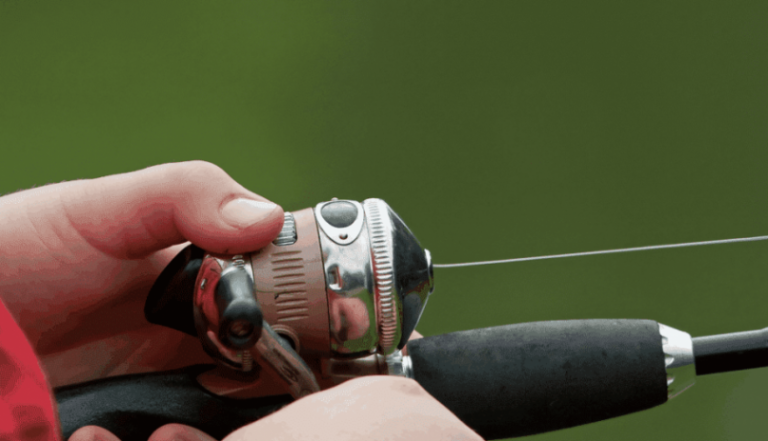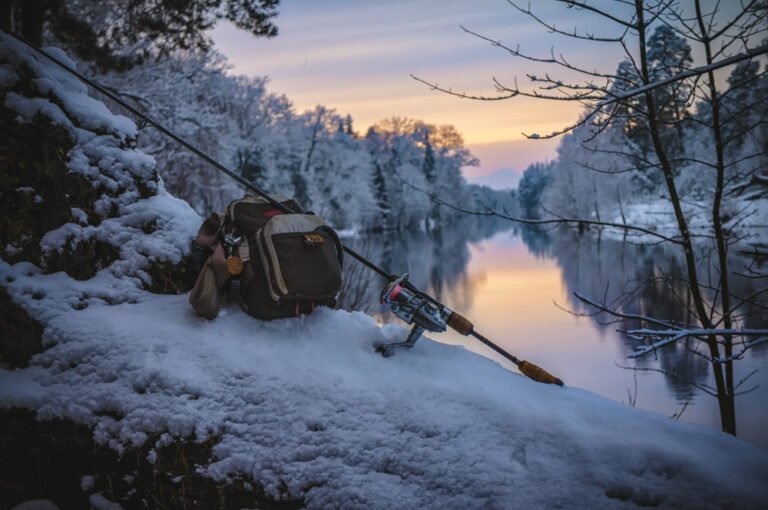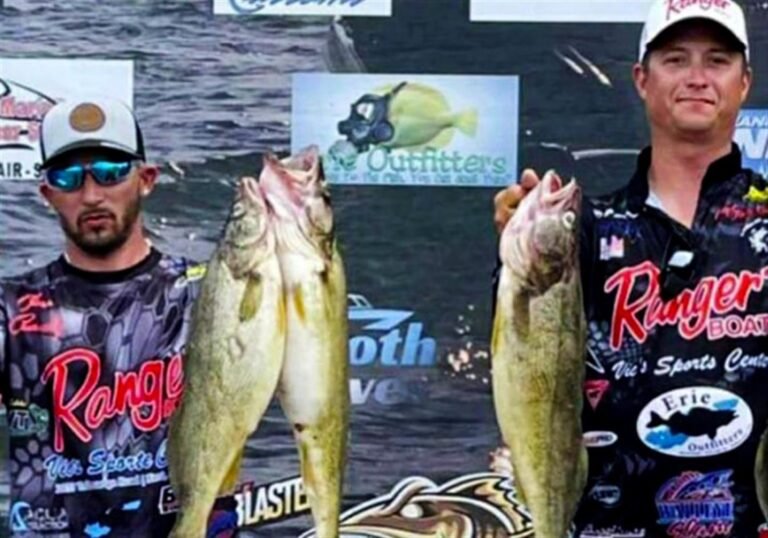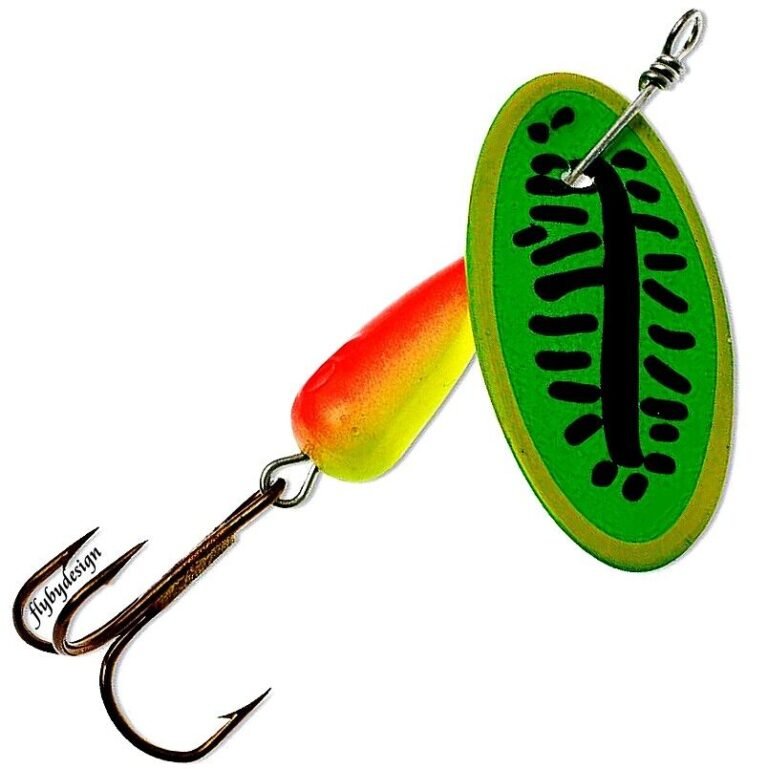Striped bass are highly adaptable fish that can be found in both saltwater and freshwater environments. Understanding their habitat preferences is crucial for successful fishing.
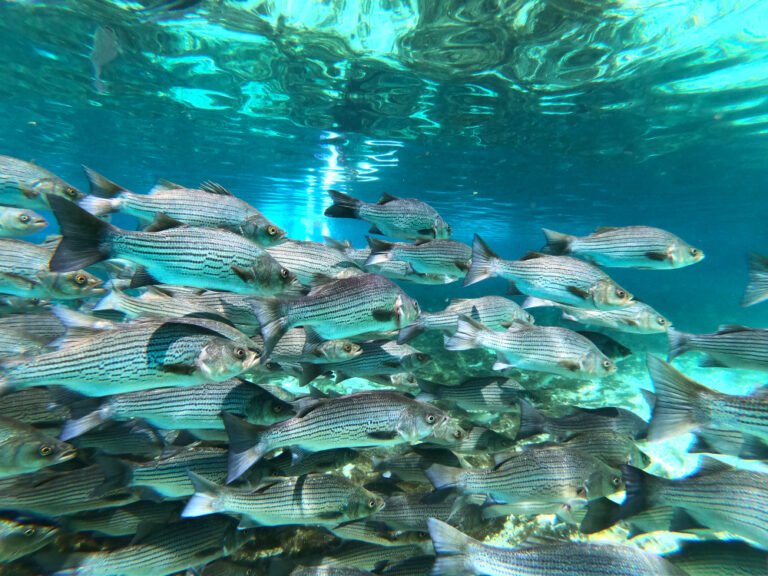
In saltwater, striped bass prefer coastal areas such as bays, estuaries, and inlets. These locations provide the perfect combination of food sources and shelter.
When it comes to freshwater, striped bass are commonly found in reservoirs with deep waters and cooler temperatures. Migration patterns play a significant role in striped bass behavior.
These magnificent creatures exhibit anadromous behavior, meaning they migrate from saltwater to freshwater for spawning purposes. In the springtime, adult striped bass embark on long journeys upstream to spawn in rivers or tributaries.
They can travel hundreds of miles to reach their preferred spawning grounds. After spawning, they make their way back to the ocean or larger bodies of water where they spend most of their time.
Feeding Habits and Preferred Prey
Understanding the feeding habits of striped bass is key to enticing them with the right bait or lure. Striped bass are opportunistic predators that primarily feed on other fish species. Their preferred prey includes herring, shad, menhaden (also known as bunker), mullet, and eels.
They are also known to consume crustaceans like crabs and shrimp when available. When hunting for food, striped bass often display an ambush strategy near structure such as rocks or submerged vegetation where prey might seek shelter.
They use their powerful bursts of speed to chase down their prey before engulfing them whole with their large mouths. During different seasons and water conditions, striped bass may exhibit varying feeding patterns.
For instance, during springtime when they migrate upstream to spawn in freshwater rivers or tributaries, they tend to feed less actively. However, in the warmer months when they return to coastal areas or larger bodies of water, their feeding activity increases as they take advantage of abundant food sources.
Understanding the habitat preferences and migration patterns of striped bass, along with their feeding habits and preferred prey, provides valuable insights for anglers aiming to catch these elusive fish. Armed with this knowledge, fishermen can strategically position themselves in the right locations and employ appropriate bait or lures to maximize their chances of a successful striped bass fishing excursion.
Essential Gear for Striped Bass Fishing
Rods, Reels, and Line Recommendations
Choosing the right gear can make all the difference in your success on the water. Starting with your rod, you’ll want a medium to heavy-action spinning or baitcasting rod that can handle the fight of these powerful fish. A rod between 7 and 9 feet in length will provide you with the necessary casting distance and control.
For your reel, opt for a quality spinning reel or a baitcasting reel with a high gear ratio. This will allow you to retrieve your line quickly when needed and keep up with any sudden bursts of speed from stripers.
Look for reels that have a smooth drag system to ensure you can handle those hard-fighting fish. As for fishing line, braided line is highly recommended for striped bass fishing due to its excellent strength and sensitivity.
A 20-30-pound test braided line should be sufficient in most situations. Pair it with a fluorocarbon leader (15-20-pound test) to increase stealthiness when targeting finicky stripers in clear water conditions.
Tackle Options: Lures, Baits, and Rigs
When it comes to enticing striped bass, having an arsenal of lures is essential. Start with topwater lures like poppers and walking baits for exciting surface strikes during low light conditions or when stripers are actively feeding near the surface.
Soft plastic swimbaits in shad or bunker imitations are also effective choices that can be rigged weedless or on jig heads for versatility. For bait anglers seeking traditional methods, live eels are considered one of the deadliest baits for trophy-sized stripers as they mimic natural prey exceptionally well.
Other popular live baits include menhaden (also known as bunker), mackerel, or herring. These baitfish can be fished either on a fish finder rig or under a bobber to target stripers at various depths.
When it comes to rigs, the classic fish finder rig is a go-to setup for striped bass fishing. This rig allows you to present your bait close to the bottom where stripers often feed.
Pair it with an appropriate sinker weight depending on current conditions. Another effective rig is the umbrella rig, which mimics a school of baitfish and can be rigged with soft plastic shad bodies for enticing strikes from aggressive stripers.
Remember, experimenting with different lures, baits, and rigs is key to finding what works best in your fishing area and during specific conditions. Don’t be afraid to try new techniques and adapt your tackle selection accordingly.
Techniques for Catching Striped Bass
Casting from Shore or Boat: Tips and Tricks
Casting is an essential skill that can make all the difference between landing a trophy-sized striper or going home empty-handed. Whether you’re casting from the shore or a boat, there are a few tips and tricks to keep in mind to maximize your chances of success.
Firstly, it’s crucial to understand the importance of precision. Striped bass are known for their keen eyesight, making accuracy in your cast vital.
Take your time to assess the wind direction and current flow before launching your lure into the water. Aim for areas with structure like jetties, rock formations, or submerged logs where stripers often hide and ambush their prey.
Another aspect to consider is the retrieval technique. Varying your retrieve speed can entice strikes from stripers with different feeding habits.
Experiment with slow retrieves, fast retrieves, and even pauses during retrieval to imitate wounded baitfish. Keep an eye out for any signs of activity on the water such as birds diving or baitfish breaking the surface – these indicate potential feeding grounds for striped bass.
Trolling Strategies for Targeting Striped Bass
Trolling is a popular technique used by anglers targeting striped bass in open waters. It involves dragging lures behind a moving boat at varying speeds to entice strikes from cruising stripers. To ensure success when trolling for these elusive predators, mastering some key strategies is essential.
One effective tactic when trolling is using planer boards. These devices allow you to spread out multiple lines at different distances from your boat, increasing your coverage area and chances of hooking into a school of hungry stripers.
Attach lures such as umbrella rigs, swimbaits, or bucktail jigs to your planer boards and set them at different depths to attract fish at various levels in the water column. Additionally, controlling your boat’s speed is crucial.
Striped bass have varying preferences when it comes to chasing down prey. Experiment with different trolling speeds until you find the sweet spot for the day’s conditions.
Keep an eye on your depth finder or fishfinder to monitor any changes in depth where stripers might be lurking. Adjusting your speed and depth accordingly can help ensure that your lures are presented in the strike zone.
Remember, whether you choose to cast from shore or troll from a boat, always stay alert and observant of your surroundings. Adapting your techniques based on changing conditions will greatly enhance your chances of landing that prize-winning striped bass you’ve been dreaming of.
Best Locations for Striped Bass Fishing
Coastal areas: bays, estuaries, and inlets to explore
When it comes to striped bass fishing, nothing beats the thrill of casting your line in the coastal waters of bays, estuaries, and inlets. These dynamic environments provide the perfect mix of saltwater and freshwater influences that attract striped bass in abundance. The brackish waters created by the merging of rivers with the ocean offer an ideal habitat for these magnificent fish.
On the East Coast, one cannot overlook the Chesapeake Bay. Known as a striped bass haven, this vast estuary stretching across Maryland and Virginia contains incredible fishing opportunities.
With its expansive network of tributaries, marshes, and underwater structures, the Chesapeake Bay offers ample feeding grounds for striped bass throughout the year. Meanwhile, on the West Coast, anglers flock to San Francisco Bay for an unforgettable striped bass fishing experience.
The bay’s diverse ecosystem nurtures a thriving population of stripers. From casting near Alcatraz Island to exploring shoreline structures near Berkeley or Sausalito, there are endless hotspots to discover.
Inland freshwater reservoirs known for striped bass populations
While coastal areas steal much of the spotlight when it comes to striper fishing, inland freshwater reservoirs also hold hidden treasures for enthusiastic anglers seeking big catches away from saltwater settings. These man-made lakes provide unique opportunities due to their size and controlled water flow.
One renowned inland destination is Lake Texoma on the border between Texas and Oklahoma. This massive reservoir is famous for its healthy population of large striped bass.
Here you can expect thrilling battles with trophy-sized stripers while enjoying breathtaking views along its 580-mile shoreline. Another exceptional location is Smith Mountain Lake nestled within Virginia’s picturesque Blue Ridge Mountains.
This stunning lake not only provides ample opportunities for striped bass fishing but also offers breathtaking scenery. With its clear waters and well-maintained fishery, Smith Mountain Lake attracts anglers from near and far.
Whether you prefer to explore the coastal delights or venture into inland freshwater reservoirs, these locations guarantee unforgettable striped bass fishing experiences. Remember to research local regulations, hire knowledgeable guides if necessary, and respect the natural environment to ensure the preservation of these incredible habitats for generations to come.
Seasonal Considerations for Striped Bass Fishing
Springtime Spawning Patterns and Optimal Fishing Techniques
As the chilly grip of winter loosens its hold, striped bass enter a period of renewed vigor and reproductive instinct. Spring is the time when these magnificent fish embark on their annual spawning migration. Understanding their behavior during this crucial phase is essential for any angler looking to reel in a striped bass bonanza.
During the spring, striped bass move from coastal areas to freshwater tributaries, seeking suitable spawning grounds. They prefer water temperatures around 55 to 65 degrees Fahrenheit, which trigger their reproductive activity.
Anglers should keep an eye on water temperature fluctuations and monitor reports from local fishing communities to determine when the spawning season kicks into high gear. Optimal fishing techniques during springtime revolve around imitating natural baitfish movements that trigger the aggressive instincts of striped bass ready to spawn or protect their eggs.
Look for shallow waters with structure or submerged vegetation where stripers tend to congregate. Effective lures include swimbaits, soft plastics mimicking shad or herring, or even topwater plugs that create enticing splashes and commotion on the surface.
Summer Tactics for Targeting Striped Bass in Warmer Waters
As summer sets in and temperatures rise, striped bass adjust their behavior accordingly. The warmer waters push them towards deeper structures where they seek relief from heat while hunting for prey. Anglers must adapt their strategies to target these elusive creatures lurking beneath the sun-drenched surface.
To locate summer stripers, focus your efforts near drop-offs, underwater structures such as rock piles or reefs, and areas with strong currents that concentrate baitfish populations. Using a fish finder can be immensely helpful in identifying underwater hotspots where striped bass are likely to gather.
Tactics that prove effective during the summer include trolling, as it allows you to cover more ground and present your lures at varying depths. Deep-diving plugs, spoons, or umbrella rigs tipped with soft plastic shad imitations can entice a strike from even the most persnickety striped bass.
Another successful technique is jigging vertically near schools of baitfish or submerged structure. This mimics the natural movement of injured prey and tempts nearby stripers into action.
Fall Migration Patterns: Intercepting Schools of Migrating Stripers
As the days grow shorter and temperatures start to cool down, striped bass embark on their epic fall migration.
It is a spectacle witnessed by fortunate anglers who witness thousands of these magnificent fish moving in unison along coastal highways. Intercepting these migratory schools marks a highlight in any angler’s calendar.
During this period, striped bass leave their summertime haunts and begin their journey towards warmer waters for wintering grounds. They follow coastlines, estuaries, and river mouths in search of abundant food sources before winter sets in.
To maximize your chances of success during this exciting migration period, keep an eye on local reports and consult with experienced anglers or charter guides who have firsthand knowledge of the migratory routes. Topwater lures become particularly effective during fall as stripers aggressively feed on baitfish near the surface to build energy reserves for the long journey ahead.
Poppers, stickbaits, or even fly fishing techniques can yield heart-pounding strikes from rampaging fall stripers. However, it is crucial to remain flexible with your lure selection since migrating schools might switch from surface feeding to diving deeper as they pursue different prey species along their route.
Winter Strategies When Striped Bass Become Less Active
When winter arrives, and the cold grips coastal waters, striped bass become less active.
Their metabolism slows down, and finding them becomes a challenging task for even the most experienced anglers. However, with the right approach and a touch of patience, winter can still offer exhilarating opportunities to reel in trophy-sized stripers.
During this period, striped bass gravitate towards deeper waters in search of warmer pockets where they conserve energy. Focus your efforts near structures that provide thermal refuge such as deep holes, channels, or near power plant discharges that generate heated water.
Keep an eye on weather patterns and wait for periods when milder temperatures or passing storms can stimulate feeding activity. Vertical jigging with heavy jigs tipped with soft plastics or bait such as eels can prove effective during winter.
Slowly bouncing your offering along the bottom mimics the movement of struggling prey which might entice a sluggish striper into biting. Patience is key during these frigid days; persistence may reward you with that elusive wintertime trophy catch.
Tips for Catching Trophy-sized Stripers
Selective breeding programs enhancing trophy-sized fish stocks
Are you a hardcore angler with dreams of landing a trophy-sized striped bass? Well, my friend, you’re in luck! Thanks to innovative selective breeding programs, the chances of encountering one of those behemoth stripers have significantly increased.
These programs focus on breeding fish that have the genetic potential for extraordinary growth. By carefully selecting and pairing individuals with desirable traits such as size, strength, and aggressive feeding behavior, hatcheries can produce offspring that are more likely to grow into true trophies.
To take advantage of this exciting development, keep an eye out for areas where these selectively bred striped bass are released. Many fishing clubs and associations stock their favorite fishing spots with these specially bred giants.
These locations often receive regular releases of young trophy-sized stripers, boosting your chances of hooking one. So do your research and find out where these programs are active near you — it could be your ticket to reeling in a monster striper!
Nighttime fishing methods to increase chances of landing a trophy striper
Fishing under the cover of darkness adds an extra allure to the pursuit of striped bass and greatly increases your odds of catching that elusive trophy fish. As the sun sets and the moon takes its place in the sky, stripers become more active and move closer to shorelines or shallower waters to feed.
This change in behavior presents anglers with a golden opportunity. To maximize your success during nighttime excursions for trophy stripers, consider using lures that create vibrations or make noise.
Topwater plugs with rattling chambers can be particularly effective as they mimic injured baitfish struggling on the water’s surface. Additionally, lures equipped with glowing or reflective features can attract curious stripers lurking beneath.
Furthermore, don’t forget about using live bait. Nighttime is when stripers go on a feeding frenzy, so presenting them with an irresistible meal can be the key to hooking a trophy.
Live eels or large chunks of fresh baitfish, such as bunker or herring, rigged with a fish-finder rig are excellent choices during these nocturnal adventures. Whether you’re utilizing cutting-edge selective breeding programs or exploring the thrill of nighttime angling, these tips will significantly enhance your chances of landing a trophy-sized striped bass.
With dedication, perseverance, and a little bit of luck, you could find yourself face-to-gills with one of those legendary monsters that anglers dream about. So don’t hesitate – cast your line and let the pursuit begin!
Conservation Efforts & Regulations
Importance of Catch-and-Release Practices to Sustain Striped Bass Populations
No discussion about striped bass fishing would be complete without highlighting the significance of catch-and-release practices in preserving the health and abundance of these magnificent creatures. Catch-and-release is a vital conservation measure that allows anglers to enjoy the thrill of the sport while ensuring that striped bass populations continue to thrive for future generations. By carefully handling, promptly releasing, and minimizing stress on caught fish, anglers can significantly contribute to the sustainability of this cherished species.
To successfully practice catch-and-release, it’s crucial to use appropriate gear such as circle hooks or single hooks, which reduce harm and increase survival rates upon release. Additionally, anglers should handle the fish with wet hands or gloves to avoid removing their protective slime layer, as it plays a crucial role in preventing infections and maintaining overall health.
Taking photographs should be done quickly and responsibly, always keeping the fish close to water for a swift return. By embracing these practices and spreading awareness among fellow anglers, we can collectively ensure that striped bass populations flourish for generations to come.
Current Regulations on Size Limits, Bag Limits, and Seasons
To safeguard striped bass populations and maintain a balance between sustainable fishing and conservation efforts, strict regulations have been established by fisheries management authorities across various regions. These regulations typically include size limits (the minimum length a fish must be before it can be legally kept), bag limits (the maximum number of fish an angler can keep per day), and seasonal restrictions (periods when fishing is prohibited or limited).
For instance, in many states along the East Coast of the United States where striped bass are prevalent, there are size limits ranging from 18 inches to 28 inches. The bag limits often vary between one or two fish per person per day, with some areas implementing slot limits that allow anglers to keep fish within a specific size range.
Seasonal restrictions are also in place, particularly during spawning periods, to protect the vulnerable breeding populations. It is vital for anglers to familiarize themselves with the specific regulations in their fishing location and abide by them conscientiously, as these measures directly contribute to the long-term sustainability of striped bass populations.
Conclusion
As avid anglers and lovers of nature, it is our responsibility to approach striped bass fishing with mindfulness and respect for the environment. By embracing catch-and-release practices and adhering to established regulations on size limits, bag limits, and seasons, we can actively contribute to the conservation of these magnificent fish. Striped bass offer not only thrilling experiences for anglers but also serve as an indicator of a healthy ecosystem.
Let us leave a positive impact on their fragile existence by being responsible stewards of our natural resources. Together, we can ensure that future generations will have the opportunity to enjoy the beauty and excitement that striped bass fishing has to offer.

